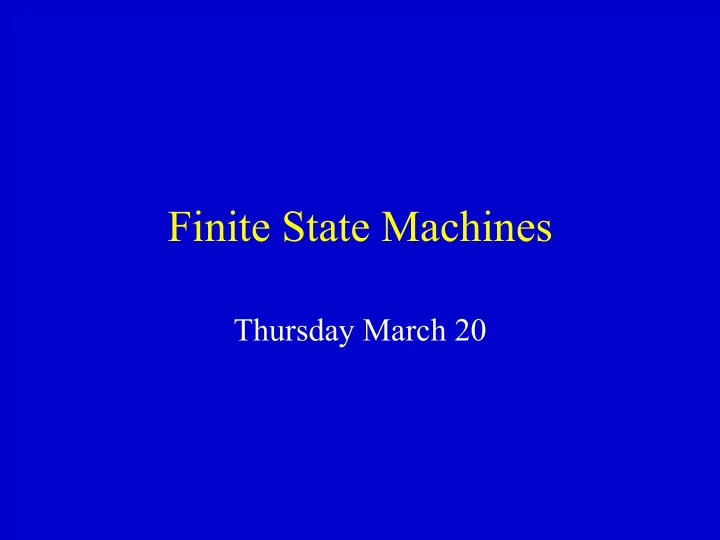

Finite State Machines Thursday March 20
Motivation – where? • Regular expressions : generalized search (and replace) – Editors, sed/awk, perl • Simple parsers for languages • Control systems of all sorts – GUI interaction model – Elevator, vending machine, car-building robot • Compilers, interpreters
Motivation – why • Provides a simple model of computation – Lots of nice results – Most are easy to prove! – But: only so powerful • Occurs a lot – And not just in computer science!
What • Informal examples (blackboard) • Notice: – Start state – End state(s) – Nodes – (labeled) transitions
Formal definition • A Finite State Machine (FSM) is a tuple (Q, Σ , δ , s, F) where – Q – alphabet of state symbols – Σ – alphabet of input symbols δ × Σ → : Q Q – - transition function (total or partial) s ∈ Q – – starting state F ⊆ Q – – final state(s)
Full Example • See blackboard again
FSM as computation • (see board drawing) • FSM with input x: – String x placed on tape one ‘letter’ per cell – Read head on leftmost cell – Current state = s – FSM started
FSM as computation (cont) • Execute cycle: – Symbol under head read (current symbol). If no symbol, terminate. – Compute next state (using current state and current symbol). If next state is undefined abort – only occurs if state function partial – Move head right – Current state := next state • Repeat
FSM as computation (cont) • Note that tape is read-only, one-way and finite • Note that controller ‘memory’ also finite, but read/write • Additionally: define the “output” of a FSM to be its last state (including undefined if necessary)
Languages • Definition: Let M be a FSM. We say that M accepts a language L (of finite strings from M’s input alphabet Σ ) if and only if – For all t in L, FSM on t ends in a final state – For all t not in L, FSM on t does not end in a final state
Motivation revisited • Regular expressions correspond exactly to languages accepted by FSM • Most control systems are FSM! – Exposing FSM of a GUI controller leads to much simpler explanation, design, coding, …
Recommend
More recommend